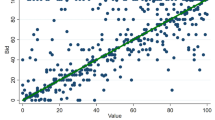Abstract
Economics is the science of want and scarcity. Weshow that want and scarcity, operating within a simpleexchange institution (double auction), can besufficient for an economy consisting of multipleinter-related markets to attain competitiveequilibrium (CE). We generalize Gode and Sunder's(1993a,b) single-market finding to multi-marketeconomies, and explore the role of the scarcityconstraint in convergence of economies to CE. When thescarcity constraint is relaxed by allowingarbitrageurs in middle markets to enter speculativetrades, prices still converge to CE, but allocativeefficiency of the economy declines.Optimization by individual agents, often used toderive competitive equilibria, is unnecessary for anactual economy to approximately attain suchequilibria. From the failure of humans to optimize incomplex tasks, one need not conclude that theequilibria derived from the competitive model aredescriptively irrelevant. We show that even incomplex economic systems which are highly inefficient,such equilibria can be attained under a range ofsurprisingly weak assumptions about agent behavior.
Similar content being viewed by others
References
Becker, Gary S. (1962). Irrational behavior and economic theory. Journal of Political Economy, 70, 1-13.
Evans, Dorla A. (1997). The role of markets in reducing expected utility violations. Journal of Political Economy, 105(3), 622-636.
Friedman, D. (1993). The double auction market institution: a survey. In D. Friedman and J. Rust (eds.), The Double Auction Market. Santa Fe Institute Studies in the Sciences of Complexity, Proc. Volume XIV, Addison-Wesley, New York.
Friedman, D. and Rust, J. (1993). The Double Auction Market. Santa Fe Institute Studies in the Sciences of Complexity, Proc. Volume XIV, Addison-Wesley, New York.
Gode, Dhananjay K. and Sunder, Shyam (1993a). Allocative efficiency of markets with zerointelligence traders: market as a partial substitute for individual rationality. Journal of Political Economy, 101 (1), 119-137.
Gode, Dhananjay K. and Sunder, Shyam (1993b). Lower bounds for efficiency of surplus extraction in double auctions. In The Double Auction Market. Santa Fe Institute Studies in the Sciences of Complexity, Proc. Volume XIV, Addison-Wesley, New York.
Gode, Dhananjay K. and Sunder, Shyam (1997). What makes markets allocationally efficient? Quarterly Journal of Economics, 603-630, May.
Goodfellow, J. and Plott, C.R. (1990). An experimental examination of the simultaneous determination of the input prices and output prices. Southern Journal of Economics, 56 (4), 969-983.
Hardle, W. and Kirman, A. (1995). Neoclassical demand: a model-free examination of price-quantity relations in the Marseilles fish market. Journal of Econometrics 67 (1), 227-257.
Hayek, Friederich A. (1945). The uses of knowledge in society. The American Economic Review, 35, 519-530, September.
Hildenbrand, W. (1994). Market Demand. Princeton University Press.
Knight, F.H. (1947). The Planful Act, Part VI. In Freedom and Reform. Harper and Brothers, New York.
Leijonhufvud, A. (1993). Towards a not-too-rational macroeconomics. Southern Economic Journal, 60 (1), 1-13.
Luo, G.Y. (1995). Evolution and market competition. Journal of Economic Theory, 67 (1), 223-250.
North, Douglass C. (1990). Institutions, Institutional Change, and Economic Performance. Cambridge University Press, New York.
Plott, C.R. (1986). Rational choice in experimental markets. Journal of Business, 59, S301-S327.
Plott, C. and Smith, V. (1978). An experimental examination of two institutions. Review of Economic Studies, 133-153.
Rothschild, E. (1994). Adam Smith and the invisible hand. American Economic Review, 84 (2), 319-322.
Simon, Herbert A. (1978). Rational decision making in business organizations. American Economic Review, 69, 493-513.
Simon, Herbert A. (1996). The Sciences of the Artificial, 3rd edn. MIT Press, Cambridge, MA.
Smith, Vernon L. (1991). Rational choice: the contrast between economics and psychology. Journal of Political Economy, 99 (4), 877-897.
Trockel, W. (1984). Market Demand, Lecture Notes in Economics and Mathematical Systems, 223. Springer-Verlag.
Wilson, R. (1987). On equilibria of bid-ask markets. In G. Feiwell (ed.), Arrow and the Ascent of Modern Economic Theory, 375-414. MacMillan, New York.
Author information
Authors and Affiliations
Rights and permissions
About this article
Cite this article
Bosch-Domènech, A., Sunder, S. Tracking the Invisible Hand: Convergence of Double Auctions toCompetitive Equilibrium. Computational Economics 16, 257–284 (2000). https://doi.org/10.1023/A:1008776705863
Issue Date:
DOI: https://doi.org/10.1023/A:1008776705863




